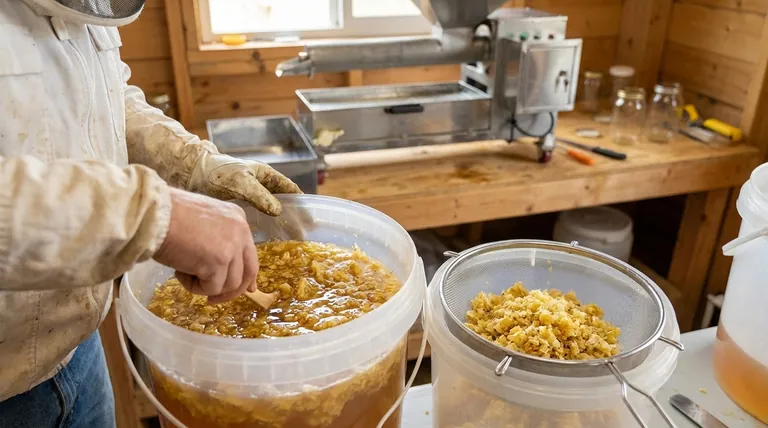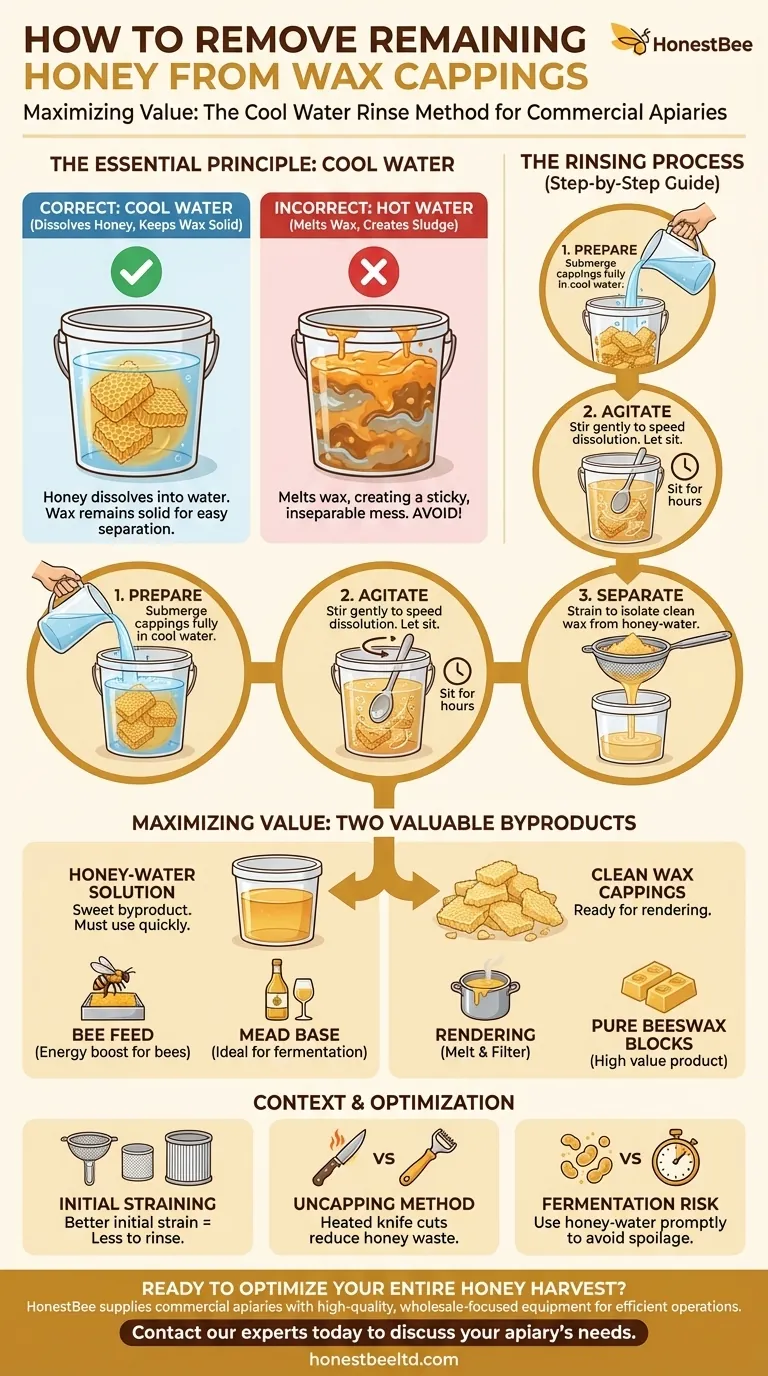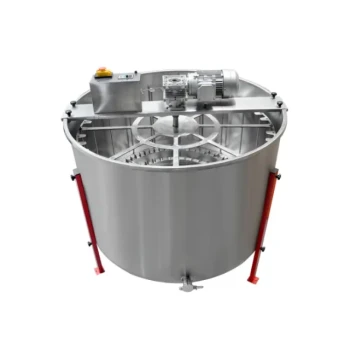To remove the last of the honey from your wax cappings, the most direct and effective method is to rinse them in cool water. This simple process dissolves the residual honey, allowing it to be separated from the wax, which remains solid. This ensures you don't waste valuable honey and prepares the wax for rendering.
The challenge isn't just cleaning the cappings, but maximizing the value of every resource from your harvest. A simple cool water rinse transforms a sticky byproduct into two distinct, usable assets: a honey-water solution and clean wax cappings ready for processing.

The Rinsing Process: A Step-by-Step Guide
Properly rinsing your cappings is a straightforward process, but the details are crucial for a clean separation of honey and wax.
Why Cool Water is Essential
Using hot water is a common mistake that will create a significant problem. Hot water will melt the wax, creating an inseparable, sticky mixture of wax, honey, and water.
Cool or room-temperature water is critical because it keeps the wax in its solid state while effectively dissolving the thin coating of honey.
The Rinsing Method
Place your honey-laden cappings into a food-grade bucket or container. Pour enough cool water over them to ensure they are fully submerged.
Agitate the cappings by stirring them gently. This helps speed up the process of the honey dissolving into the water. Let the mixture sit for several hours, or even overnight, stirring occasionally.
Separating and Straining
Once the honey has dissolved, pour the mixture through a strainer, nylon bag, or cloth to separate the now-clean wax cappings from the honey-water solution. You may want to give the cappings a final quick rinse to remove any last sticky residue.
Maximizing Value from Your Byproducts
The goal of this process is to create two new resources. Both the resulting honey-water and the clean wax have important uses.
Utilizing the Honey-Water Solution
This sweet water is a valuable byproduct. It can be used as a supplementary feed for your bees, giving them a boost of energy from their own honey.
Alternatively, many beekeepers use this solution as the base for making mead. The sugar content is often perfect for starting fermentation.
Preparing Wax for Rendering
With the honey removed, your cappings are now ready for the final stage of processing: rendering. The clean wax can be gently heated and filtered to remove any remaining impurities.
Once melted and cleaned, the wax is poured into molds to cool and solidify into pure blocks of beeswax, a valuable product in its own right.
Understanding the Context and Trade-offs
This rinsing step doesn't happen in a vacuum. Its efficiency is influenced by the steps that come before it in the honey extraction process.
The Role of Initial Straining
How well you strain your honey initially will determine how much is left in the cappings. Small-scale operations often use simple nylon or cloth filters. Large-scale operations may use more complex systems, but the principle is the same: the better your initial strain, the less honey you'll need to rinse out later.
How Uncapping Method Matters
The tool you use to uncap the frames—whether a pronged fork, a serrated knife, or a heated knife—affects how much honey is retained in the wax. While some residual honey is inevitable, a clean cut with a heated knife often results in less waste compared to a manual scratcher.
The Risk of Fermentation
The honey-water solution is a perfect environment for wild yeasts to grow. It will begin to ferment quickly if left at room temperature. You must use, freeze, or begin fermenting it into mead promptly to avoid spoilage.
Making the Right Choice for Your Goal
The final step in your harvest is about maximizing value. How you approach cleaning your cappings should align with your specific objectives.
- If your primary focus is maximum honey yield: Rinsing your cappings is a non-negotiable step to capture every last recoverable drop.
- If your primary focus is high-quality beeswax: A thorough rinse is essential for creating clean, pure wax blocks free of caramelized honey residue.
- If your primary focus is overall efficiency: This process turns a single waste product into two valuable resources, making it one of the highest-value steps in your workflow.
By properly managing your cappings, you ensure that no part of the harvest goes to waste.
Summary Table:
| Step | Key Action | Purpose |
|---|---|---|
| 1. Prepare | Submerge cappings in cool water. | Dissolves honey without melting wax. |
| 2. Agitate | Stir gently and let sit for hours. | Speeds up honey dissolution. |
| 3. Separate | Strain mixture through a cloth or bag. | Isolates clean wax from honey-water. |
| 4. Utilize | Use honey-water for feed or mead; render clean wax. | Maximizes value from byproducts. |
Ready to optimize your entire honey harvest?
As HONESTBEE, we supply commercial apiaries and beekeeping equipment distributors with the high-quality, wholesale-focused supplies needed for efficient operations—from uncapping knives and strainers to rendering equipment.
Let us help you maximize the value of every harvest. Contact our experts today to discuss your apiary's needs.
Visual Guide

Related Products
- Honey Wax Separating Wax Press with Metal Screw Wax Separator Machine
- 8-Frame Electric Self-Reversing Honey Extractor Spinner for Commercial Honey Extraction Equipment
- 10L Stainless Steel Honey Wax Press Extractor for Wax Cappings
- HONESTBEE 3-Frame Manual Acrylic Honey Extractor
- Stainless Steel Manual Honey Press with Guard for Pressing Honey and Wax
People Also Ask
- What is the purpose of the Wax Screw Presses set? Maximize Honey & Wax Yield Efficiently
- What equipment is used to separate beeswax from honey in cappings? Match the Right Tool to Your Apiary's Scale
- What is a honey press and what is it used for? A Guide to Simple Honey Extraction
- How does the honey screw press operate? A Guide to Maximizing Honey Yield from Cappings
- What are the main differences between centrifugal extractors and honey presses? A Guide for Commercial Apiaries



















